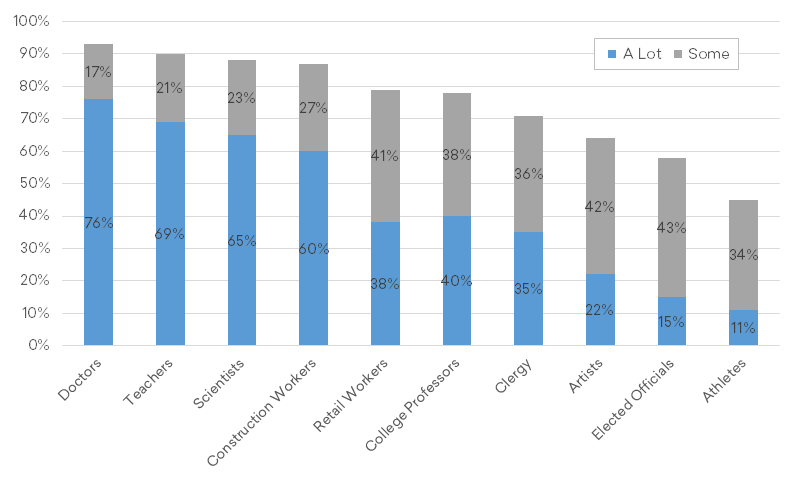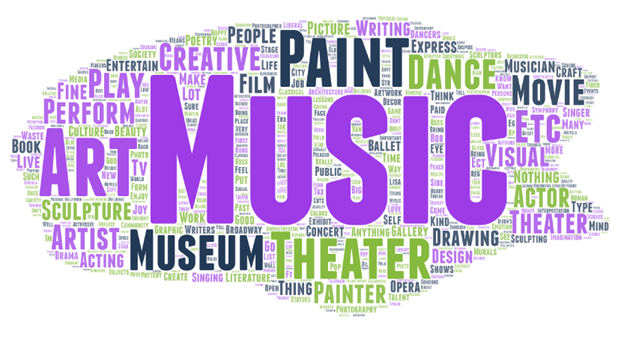Americans value the arts. 81 percent of Americans believe the arts are “a positive experience in a troubled world.”1 Yet, Americans do not always place value on those who create that art. In July 2021, the American Academy of Arts & Sciences asked Americans how much artists, among a number of other professions, “contribute to the general good of society.” While 64 percent of Americans believe they contribute “a lot” or “some,” only 22 percent answered “a lot.”2 How can we square this apparent mismatch?
First, consider who came out at the top of the list. Doctors topped the list, as 93 percent of Americans believe they contribute “a lot” or “some” to society; followed closely by teachers (90%) and scientists (88%). Retail workers and college professors were in the middle (at around 78%). Athletes, in contrast, were at the bottom of the list at 45 percent, with elected officials only modestly above them at 58 percent.
The answers reflect our particular moment—a global health crisis and pervasive political mistrust. But in the case of artists, these responses also have a history. A similar survey in 2009 revealed that 74 percent believed artists contribute either “a lot” or “some” to the well-being of our society, with 31 percent selecting “a lot.”3 A similar national poll in 2003 returned only 27 percent answering “a lot” for artists.4 But if many Americans consume the arts on a daily basis, why might they not recognize the contribution of artists to that enjoyment? And is this lack of recognition a problem?
One clue might be in the answers to another question we asked in our survey: “When you think of the arts, what comes to mind?” Respondents were much more likely to offer words for art forms (“music”), practices (“paint”), and institutions (“theater”) than those for individual creatives like “artist,” “painter,” “musician,” or “actor.”
Another question on the Academy survey points to the public’s lack of information about the work life of artists. Asked if “In your opinion, would you say artists in your area are financially suffering due to the COVID-19 pandemic,” the majority chose either “more than other workers” (29%) or “the same as other workers” (32%). But a revealing number of people chose “Don’t know” (33%). As the Academy’s Commission on the Arts notes in their new report on the creative workforce, by September 2020, more than half of actors were unemployed, along with 27 percent of those in music-related jobs.5 Nonprofit arts, entertainment, and recreation organizations lost over 31 percent of their jobs from February 2020 to March 2021—five times the job loss for nonprofits overall.6
The Academy survey revealed that some groups are more convinced of artists’ societal contribution than others. Women are more likely to say artists contribute “a lot”/“some” than men (69% vs 59%). Those with a BA or higher degree are more likely to believe that artists contribute “a lot”/“some” than those with either a high school education or some college (72% versus 56% and 61%). Race/ethnicity and income level were not found to be related to the perception of artists’ contribution.
Taken together, it might not be surprising, then, to learn that data on charitable giving from 2020 shows that while giving overall went up from 2019 to 2020, giving to arts, culture, and humanities organizations fell by 8.5 percent, and only represents 4 percent of total charitable giving. At the same time, charitable giving in that sector has increased substantially since the mid-1980s, both in dollar amount and as a share of all giving.7
At the center of this question is the issue of how we recognize, and nurture, contributions to the good of society. What is it that we value, how do we develop it, and how do we create space for that value to grow? Money is one way we recognize value—but it doesn’t always line up with who we say contributes the most. For instance, doctors (who ranked high in our survey) are generally well paid—median annual wages of a family physician in 2020 were $207,380.8 The median wages for a fine artist were $52,340.9 Yet, median wages of teachers, who ranked nearly as high as doctors as far as societal contribution, were less than a third of what doctors earned, at $60,940 (elementary teachers).10
The Academy survey and the other information presented here supplement the new report from the Commission on the Arts of the American Academy of Arts & Sciences, Art is Work: Policies to Support Creative Workers, which lays out the case for the value of the creative workforce. The recommendations from the Commission are geared towards closing the gap this survey reveals between the importance of the arts in the everyday lives of many Americans and the support American institutions offer to allow artists—who create the arts—to thrive.


